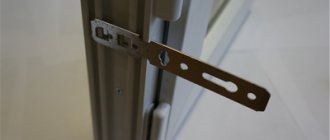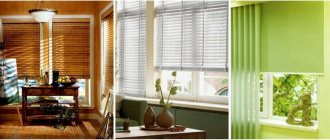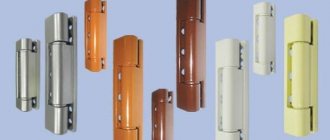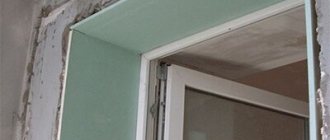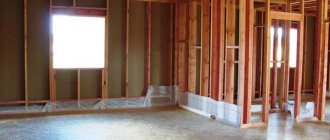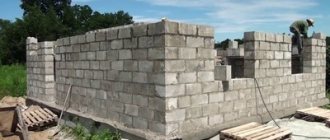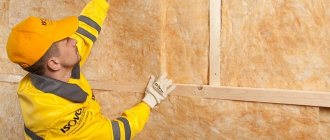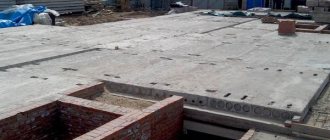provides services for the production and installation of double-glazed windows with a hole for ventilation in Moscow and the region at a price of 12,500 rubles/m2.
IMPORTANT! As a rule, it is not advisable to make a hole in a finished double-glazed window! The hole is cut out at the stage of manufacturing a new double-glazed window according to pre-taken measurements!
Why are plastic windows drilled?
- attach a certain type of slopes to the window structure;
- mask the installation seams with strips;
- install a television or internet cable;
- install blinds;
- install LED strip and so on.
In many cases, you can play it safe and do without drilling the window, but there are situations when it is really necessary.
Wind-K 125 ST – low noise
Exhaust fan installed in a window. It features controlled blinds and a timer. The latter function allows you to automate the operation of the device by setting a program for turning on or off the electric motor at certain intervals.
The design includes a protective cap that completely blocks the air flow when stopping. The quality of workmanship and proper balancing allowed the fan to achieve low noise during operation.
Pros:
- Quiet during operation, does not whistle like a jet plane.
- Price, cap - it doesn't show through the window.
- Timer: programmed, turned on and forgotten.
Minuses:
- Pull cord switch, it can be more expensive, but to work from the remote control.
Decorating a new window opening
Having installed a new plastic window, mounted the slopes and carried out the rest of the planned repair work, you need to think about the decor.
Curtains on the windows not only protect our personal home space from prying eyes, protect furniture from fading, but also allow us to create comfort and the desired level of intimacy due to blocking sunlight. Curtains also serve as an integral element of the interior, which has a place in any design idea.
1. What is a roller blind?
Elicent VITRO 6/150 PA – automatic blinds
A device mounted on a window transom or directly on a double-glazed window. Designed to move air masses outside to update the air composition. The fan is equipped with an automatic system for opening and closing protective shutters.
The latter are made taking into account the effects of atmospheric moisture, solar radiation, and temperature changes. It is possible to work with a programmable timer to set the frequency and duration of fan operation.
Pros:
- Automatic operation mode, setting a timer simplifies control.
- It is quite compact and light weight, which allows it to be installed directly into a double-glazed window.
- Works in the kitchen, easily removes odor and smoke when something burns on the stove.
Minuses:
- A bit noisy, but not too much.
Plastic windows with increased sound insulation
Installation of window systems with increased noise insulation up to 75 dB is a reliable and proven solution for anyone who wants to enjoy silence in an apartment, office or country house. Such designs have a number of features.
Depending on the configuration, prices for soundproof windows can vary greatly. Our company’s specialists will help you select a high-quality window system for your property.
Plastic blinds for plastic windows
There are different ways to protect a room from direct sunlight and from prying eyes. Standard solutions in the form of curtains and curtains do not suit all owners, because textile products do not always fit into the interior of a modern room, take up space, and collect dust.
Blinds, which have long since moved from office premises to apartments and have a wide variety of types for every taste, are devoid of all these shortcomings.
If you are hesitant to purchase blinds just because you don’t know how they are attached to modern double-glazed windows and whether it is possible to drill plastic windows, you can safely go to the store. Let's find out how to hang blinds with your own hands, without resorting to the help of specialists.
ERA HPS 15 – inexpensive
An axial type fan built directly into the window opening - a window transom. A check valve is provided, controlled by a cord switch. Opening the protective device - towards the street, outwards.
Durable ABS plastic is used for the housing and impeller, resistant to moisture, ultraviolet radiation and temperature changes. Optimal for work in small rooms, kitchens, change houses.
Pros:
- Lightweight, quite economical, simple operation.
- The price is just right for installation in the kitchen.
- Easy installation, especially on wooden windows.
Minuses:
- I had to work on a collective farm to make a transition trim for the window. There are no ready-made ones for sale.
Features of the material
Any material has its own unique characteristics and features. Glass is no exception. Therefore, before giving advice on how to drill glass, you need to understand what kind of material it is.
As you know, glass is produced by melting various substances at a temperature of 2.5 thousand degrees. Depending on what chemical elements were the basis of the glass, oxide, sulfide and fluoride glass are distinguished.
Bottles for various drinks are made of oxide (to be more precise, silicate) glass. But this is a very general classification. If we take into account the characteristics of the material, we can distinguish ordinary quartz glass (obtained by melting quartzite), optical glass (used in optical instruments), resistant glass (with a high degree of resistance to aggressive environments), and industrial glass.
Considering that it is industrial glass that is used most often, the question of how to drill glass at home arises precisely in relation to it. Therefore, let's consider this category in more detail.
Glass for industrial use is also divided into several types:
We have studied the types of glass, and now let’s move on to the question of what glass is used to drill.
BPP 15 BVN (Bahcivan) – reverse
Household series window fan. The power housing and impeller are made of durable, weather-resistant plastic. The built-in reverse function allows the design to operate in two modes, supply or exhaust.
This allows you to remove stagnant dirty air from the room, followed by renewal of the air mass due to the forced pumping of a fresh portion. The process speeds up the restoration of a comfortable environment in a residential or commercial premises.
Pros:
- Performance, reverse function.
- Cord operating mode switch.
- He works in a small bakery and does his job well.
Minuses:
- Mechanical switching.
Features of a double-glazed window with a hole
Such design solutions have a number of features:
- They, just like standard models, have heat-saving functions. The hole is not cut out in a finished window, but is made according to industrial standards, taking into account a hole of suitable diameter. In this way, the vacuum condition is not violated, because the requirements for the density of the space between the glasses are one hundred percent met.
- A glass unit with a hole does not lose its strength. You will not be afraid that the window is fragile and requires special care during operation.
- The edges of the hole are not sharpened. There are no drainage holes in the window; this can be done even on. There is no risk of cutting your hand. To process the edges of the cut, special devices and seals are used.
Ceiling fans
The outer wall exhaust grille, connected by a vent to the ceiling fan, is installed in the same manner as for a wall exhaust fan. This is often the easiest design to install since you only have to cut a round hole without damaging the ceiling joists.
A plastic duct is then routed from the fan towards the outside wall or under the eaves of the roof, where it is connected to the grille at the exhaust vent. Under the roof overhang, this grille cuts into the soffit in the same way as a soffit fan.
What do you need for work?
Depending on the purpose for which you are making a hole, during the work you may need:
- screwdriver (medium power);
- screws (bolts, self-tapping screws with a stable base and without a curl at the tip);
- necessary drills (mainly for metal);
- ruler;
- pencil;
- screwdrivers.
As for who should carry out the work, you can drill plastic windows yourself - if you have the skills to use the tool and know the intricacies of the process. In other situations, leave it to the professionals.
Consumables
To drill the frame you can use:
- bolts;
- self-tapping screw;
- press washer;
- roller blinds;
- quick installation;
- screw.
There are no special self-tapping screws for drilling plastic windows. For better fastening, it is necessary to use a metal drill slightly smaller than the diameter of the self-tapping screw so that it is screwed in evenly and without deformation.
On a note! Manufacturers often recommend purchasing countersunk screws that are coated with zinc. They have their drawbacks - they cannot be screwed in without using a special drill, since they have a thin rod.
Self-tapping screws with a screw at the end are best suited due to their good screwing into the plastic surface.
Self-tapping screws
A correctly selected self-tapping screw will make the work easier and will not damage the window. Craftsmen use self-tapping screws measuring 9.5 or 16-17 mm in length to install various decorative and functional elements on the window. Also, the self-tapping screws must have a stable shaft and a thin base; there should be no curl at the tip.
The main mistakes made when inexperienced drilling:
- Do not screw a self-tapping screw into or near a glazing bead.
The glass that makes up PVC window structures is durable and highly resistant to damage. However, if the self-tapping screw is not carefully inserted into the glass unit, the glass may crack and become damaged. In this case, you will have to completely replace the internal structure of the window, which will cost an amount equal to a third of the cost of the entire window. - An incorrect length of self-tapping screw can disrupt the tightness of windows and internal chambers, which will lead to a violation of the integrity of the structure, heat and sound insulation properties. Also, incorrect screws can damage the operation of the window.
- If drilling is done incorrectly, it will not be possible to disguise the error.
Tools
Considering that you will be working with glass, it is necessary to use a power tool that does not create vibrations. You need to choose tools with a low number of revolutions per minute, about 250 units will do for a start.
Drills must be specialized. Eg:
- Feather. The working part is pointed, triangular in shape.
- Tubular. The working part is hardened, diameter from 12 to 80 mm.
- Crown with diamond abrasive. The material is very strong and can withstand heavy loads. Diameter – 80 mm.
Drilling technique: number of revolutions – 200-300 per minute, frequency of work – 10-15 seconds. It is necessary to allow the drilling site to cool before the next approach. The position of the drill is strictly perpendicular. There is no need to apply pressure to the tool.
O'Erre Smart 15/6 M – five modes
Reversible window fan with the ability to set one of five rotation speeds. A reverse option is provided. The principle of operation of the device is supply and exhaust. Control is via a remote electronic remote control.
The curtains are opened or closed manually, using a telescopic insert that is adjusted to the actual thickness of the window. The plastic of the grille and body are made in a splash-proof design. The structure is fully prepared for installation in a window opening.
Pros:
- Five rotation speeds, remote control.
- Possibility of installing reverse.
- Rain, wind and sun resistant plastic.
Minuses:
- Consumers do not note any negative aspects.
Places where you should absolutely not drill
The fragile places on a plastic window are the glass unit and the latches that secure the glazing beads. If you drill directly around the perimeter of the latch that holds the bead, there is a high risk of damaging the glass unit. The most unfavorable place for drilling is the distance from the edge of the bead seal to the bottom border, this is at least 20 mm. It is dangerous to start drilling in this area. Behind the bead seal there is a double-glazed window recessed into the profile. It is advisable to choose another safe point and make the required number of holes there.
It is strictly forbidden to drill into moving elements of the window system. This will disrupt the operation and render the seal and the entire window structure unusable. It is better to choose the optimal location in a blind sash or window frame, avoiding dangerous areas.
Systemair BF-W 230A Window fan – installation on a window or wall
Window fan to create air flow to renew the air mass inside the room. Can be installed directly on a window or wall.
The design is equipped with a gravity check valve, which is opened by the pressure created when the device is turned on. Closing - when disconnected.
The fan is installed in residential, domestic and civil premises. Used in catering establishments. It features high performance with low power.
Pros:
- Performance with little power.
- Universal installation.
- Gravity check valve.
Minuses:
- Very noisy at full load.
What is used to drill glass?
A regular drill for drilling glass will not work; you need to use special tools.
You need to select a drill with specific parameters:
- its diameter must correspond to the diameter of the hole that needs to be made;
- the length must correspond to the thickness of the glass to be drilled;
- the shank should be round (if you plan to use a drill) or hexagonal (if you want to use a screwdriver).
What types of glass drills exist:
- "Feather". The working part of this drill is shaped like a feather and made of hard alloy. Perhaps this is the most budget-friendly tool that can be used to drill glass (as well as ceramics and tiles). This type of drill should be chosen if the diameter of the hole to be made is from 3 to 12 millimeters.
- "Crown" (tubular drill). It is designed for drilling larger holes (12-80 millimeters).
- Feather cutting drill. It is designed to make holes of even larger diameter. Its peculiarity is that the working surface has a central tip for the primary recess and teeth around the circumference.
- "Cylinder". In fact, this is an ordinary cylinder, one cutting edge of which is coated with diamond sputtering. They are used only with forced cooling.
How to vent through a wall
In some cases, it is convenient to make the air duct independent, especially if integration into the main system is associated with technical difficulties or there is no such system at all. For example, when it is necessary to install ventilation or an exhaust hood:
- In the kitchen;
- In the bath;
- In gym;
- In a workshop.
It is much more convenient to route the air duct through the nearest wall. It should be taken into account that the horizontal position of the pipe significantly reduces natural draft. Therefore, a device with forced air supply is most often chosen. The system will work more efficiently if there is an inlet that guarantees the flow of fresh air. Otherwise performance will be reduced.
Optimal hole placement
The design of the system is carried out taking into account the knowledge of certain aerodynamic laws, the main one of which is that hot air rises upward and cold air tends downward. If the exhaust ventilation openings are located as high as possible, and the supply openings as low as possible, then the resulting difference in temperature will create convection currents sufficient for natural draft. Active movement of air masses will effectively solve the following problems:
- Remove smoke, odors, suspension;
- Reduce indoor humidity;
- Normalize the quality of air in terms of oxygen content;
- Reduce temperature if comfortable values are exceeded.
If ventilation is arranged according to the principle of natural draft, then the air duct should not have horizontal sections and a large number of turns. In such cases, it is better to integrate a fan into the system, providing forced air supply.
Diamond drilling
Residents of panel and monolithic houses face a serious problem when it is necessary to make a hole in a wall or floor slab. A small vent for ventilation in the kitchen, which is highly desirable, can turn into a complex and time-consuming operation if done independently. One of the most productive ways to make a hole in a wall is diamond drilling. The optimal solution for city apartments, since the technology has the following advantages:
- Speed of work. It is considered the fastest way to make a hole in a concrete wall;
- There is no vibration or shock load and, as a result, the wall and decoration of the room will not be damaged;
- Silence. The principle of operation differs from the functions of a rotary hammer and when performing the work there will be no noise for the inhabitants of the home and their neighbors;
- Purity. There is almost no debris and dust when using diamond drilling equipment.
The work is carried out using a special tool. Professional equipment is quite expensive and it is unreasonable to purchase it for a one-time job. You can make small holes yourself using a powerful drill or hammer drill with a drilling mode. But even in this case, buying diamond crowns will not be cheap. In most cases, it is more profitable to invite specialists.
Hole for ventilation using a hammer drill
If a home craftsman has a hammer drill, then you can make an opening for installing a ventilation duct yourself. There are several ways to make an inlet hole:
- Using crowns of the required diameter;
- Using a standard drill of small diameter, drilling holes along the contour and then removing the middle using a hammer, sledgehammer and additional accessories from a hammer drill kit;
- Using standard peaks and chisels.
The last method is the most labor-intensive, dirty and noisy. A hole made in the wall with your own hands in this way will turn out sloppy, with numerous chips and defects. It's better to buy a crown. The edges will be much smoother, the diameter will be more precise, which will make further operations easier.
Difficulties and mistakes, their consequences
Ignorance of the design features of windows and possible “weak” fastening points makes the drilling process dangerous. It is often difficult to cope without professional help, since even with a good result of drilling, errors may remain. To check their corrections, professional help is precisely what is needed.
Many people who have carried out such manipulations advise immediately contacting specialists, since this will cost less than the subsequent correction of unpleasant consequences.
It is also important to note that there are methods for attaching and running various wires that do not require making holes in window structures.
Consequences of unsuccessful drilling:
- Loss of rigidity of the window structure, since the frame consists of a thin sheet of metal and is completely hollow inside.
- The box is depressurized, moisture and cold enter the room, the glass becomes covered with condensation.
- Damage to the locking mechanism, which requires replacement of the entire window sash
- Violation of the aesthetic quality of the window
Is it worth doing it yourself?
When drilling windows, care and accurate calculations are needed, since this activity is not only important, but also dangerous. If you do not have skills in this area, you need to carefully study the technical material or ask for advice from professionals.
Specialists know about the structure of structures and the nuances of various models, the location of air chambers in which holes need to be drilled.
There are also vulnerable points in the design of windows, in case of accidental damage the window must be quickly sealed.
The conclusion is simple: if you are confident in your knowledge and skills, you can make the holes yourself. If you don’t want to take risks, you can call professionals.
Tricks when working with glass
When working with glass, there are some nuances and tricks that will help facilitate the process of creating a hole in the glass.
We have already figured out how to drill glass, now let’s move on to useful tips:
- Many people have experienced that when drilling glass, chips and cracks occur. This can be avoided by simply smearing the glass near the future hole with honey and turpentine.
- During the drilling process, you need to apply literally minimal effort, and in no case put too much pressure on the glass. You need to set the drill speed to minimum.
- Some people will ask: is it possible to drill glass by swinging the drill from side to side? This is a very bad idea. Cracks will be inevitable. The drill must be held strictly perpendicular to the surface of the glass.
- We periodically take breaks of literally ten seconds to let the glass cool down.
- In this case, the drill also needs to be cooled in water so that it does not melt the glass.
- To degrease the glass surface before drilling, you can use not only alcohol, but also acetone.
- You cannot drill holes at a distance of less than one and a half centimeters from the edge of the glass.
Non-standard methods of drilling glass
In fact, there are even more creative ways to drill through glass, even compared to using sand. How else can you make a smooth hole in a glass surface?
Using copper wire
If you don't have a drill handy, you can try taking a drill and fixing copper wire in its chuck. But you won’t be able to drill a hole without a special mixture (two-thirds turpentine, one-third camphor and a little abrasive powder). This mixture is applied to the drilling site.
Metal tube
The method here is the same. We fix the tube with a smoothly sawn end in the chuck, and apply the same mixture to the drilling site as in the previous paragraph.
Serrated metal tube
And again - the same method and the same mixture of camphor, turpentine and abrasive. But this time we take the tube not with a smooth cut, but with teeth cut at one end (it is worth remembering that they must be the same).
And finally, it’s worth mentioning how to drill tempered glass. Remember: it is better not to do this at home. It is worth contacting specialized companies.
Application of glass cutter
Of course, the list of ways to make a hole in glass would be incomplete without one more method - using a glass cutter.
This method is mainly used if you need to make a hole of a very large diameter. It’s worth mentioning right away that in addition to the glass cutter, you need to use a special tool - a glass-cutting compass.
So, we drill the glass, or rather make a hole in it like this. First, mark the contours of the hole with a marker, then place a compass in the center and carefully trace the contour with a glass cutter.
Advice: under no circumstances press too hard on the glass cutter; trace the outline very smoothly.
After this, we tap the entire contour with the handle of a glass cutter and lift the cut circle of glass on the suction cup. If you need to remove excess glass, you should use special tongs. It is necessary to process the edges of the cut with a file or abrasive to remove sharp edges.
Cost of drilling holes in glass and mirror
| 4 - 19 mm | |
| Hole Ø 5-70 mm | 150 |
| Cutout | from 300 |
The cost is indicated in rubles. per piece
The cost of the service depends on several important parameters, such as:
- thickness of processed glass;
- type (glass, triplex or mirror);
- diameter of the required hole;
- post-processing (grinding)
Examples of drilling work
Scheme of work
Features of drilling holes in glass
The use of an ordinary tool designed for drilling wood, metal and concrete inevitably leads to damage to the glass workpiece, its partial or complete destruction. For this, a special tool with a sharpened arrow-shaped blade and diamond coating is used.
Immediately before the procedure, the glass is prepared properly - the surface is degreased and dried. In the process, an important role is played by the surface on which the material is located - it must be perfectly flat.
Of particular importance is the speed of rotation of the drill and the pressure it produces. Even with small deviations, the glass blank instantly becomes unusable. To prevent the glass from bursting due to overheating, water is constantly added to the drilling site - this helps reduce the temperature and avoid deformation. To protect the workpiece from stressful overloads, it is drilled from both sides at once.
When choosing the location and size of the hole, it is necessary to consider that:
- the size of the hole must be no less than the thickness of the glass being processed;
- the distance from the edge of the workpiece to the hole itself must be greater than or equal to the diameter of the hole.
It is prohibited to drill into tempered glass, since any attempt to process it will immediately break the glass into many small fragments. In order to obtain holes in tempered glass, it is necessary to first carry out a drilling procedure and then a tempering process.
Drilling holes in the mirror
For convenience, any bathroom mirror is equipped with shelves, hooks or glasses. To install this kind of fittings, you need to make holes for fastening parts.
To drill holes in the mirror, use the same tools as for glass. Restrictions on the location and size of holes in the glass also apply to the mirror.
Why are window fans less common in post-Soviet times than in the USSR?
Those who lived through the times of the USSR and perestroika probably remember that there used to be fans in many old windows. But in the new plastic frames they are practically invisible.
There are several reasons:
- Cheap kitchen hoods, air handling units, and supply valves have appeared on the market. Previously, the owners didn’t really have any alternatives, so they installed fork fans.
- There are few ready-made offers on the market. Since such designs are not in mass demand, manufacturers are in no hurry to increase the range and do not conduct extensive advertising. And it turns out to be a vicious circle: no advertising and offers - no demand; no demand - no offers and advertising.
- Windows with a built-in fan are more expensive than regular ones. And since PVC windows themselves are not cheap, not every client is willing to pay even more.
- If the user wants to install a fan with windows already installed, a hole will have to be cut in the glass. Whether it will be possible to do this correctly is no guarantee. Therefore, if the windows are already installed and there are no plans to change them, it is easier to install a supply wall installation or valve: it will be easier, and you won’t have to risk the glass.
Vortice Vario 230/9″ AR – full functionality
High quality product from an Italian manufacturer. The window fan can operate in supply and exhaust mode. Equipped with automatic blinds. High-quality materials and ball bearing supports significantly increased the overall service life of the assembled product.
Increased rotation speed and productivity. The outer grille is made in a weather-resistant design. The body and blades are made of impact-resistant polymer. Power supply: from a stationary power supply of 220 volts.
Pros:
- Supply and exhaust ventilation, automatic blinds.
- Reliability, durability, service life.
- Easy installation and operation.
Minuses:
- High noise at full load.
- The price is high.
Description
A conventional window hood is a compact device with low weight. It is installed in a window opening and significantly improves air circulation indoors. Using such a mechanism, it is possible to organize full ventilation of the room and ventilation of individual zones.
A lightweight fan is attached in two ways: on top of a window (wooden, plastic) or replaces a small part of it. Often it is covered with blinds or curtains. The latter open during operation of the device.
This hood operates completely silently and allows you to quickly freshen the air in the room. Its use is considered more hygienic than opening a window, since it prevents dust from entering the room.
